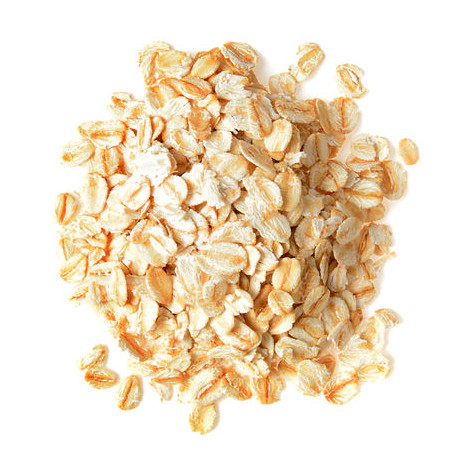Rolled Oats
Also known as old fashioned oats
What are Rolled Oats?
Rolled oats are whole dehulled oat berries (groats) that have been lightly steamed and passed through rollers to flatten or flake the groat. They are commonly used to make oatmeal. Oat products are an excellent additive to many baked goods, including cookies and multigrain bread, for two main reasons:
- Very high level of soluble dietary fiber, mainly beta-glucan
- Gluten-free oat proteins when properly produced
Practically and due to common contamination with wheat, oats should not be used to bake gluten-free products intended for people who suffer from celiac disease.
Origin
Rolled oats come from the cereal plant Avena sativa with seeds used as food. The capability of cutting oats, coupled with the development of roller mills, provided the basic technology needed to produce rolled oats as we know them today.
Nutrition and health
Oats are whole grains, gluten-free (if carefully harvested, handled and stored), high in β‐glucan (soluble fiber) and have low caloric value (363 Kcal/100g).
Proximate constituents and energy values for rolled oats:1
| Component | Value (g / 100 g of serving) |
| Fat | 8.0 |
| Cholesterol | 0.0 |
| Carbohydrates | 59.0 g |
| Dietary fiber | 9.0–10.0 g |
| Sugars | 1.0 g |
| Protein | 14.0 g |
| Ash (mineral content) | 1.8 |
Oatmeal contains the highest levels of soluble non-starch polysaccharides (NSPs) (4.5 g / 100 g). About 58.0% of the total NSPs in oatmeal are soluble, a much higher proportion than in all the other cereals. Similar to barley, the soluble NSP fraction in oats is predominantly composed of glucose which reflects its high level of β- glucan.
Furthermore, β-glucan exhibits several physiological effects that are of potential benefit to health. The ability of β-glucan to lower elevated plasma cholesterol and reduce the risk of heart disease has been recognized in health claims. Oat β-glucan can also exert several beneficial gastrointestinal effects, including decreasing postprandial glucose responses, delaying gastric emptying, and increasing satiety. β-glucan is degraded in the large intestine by bacterial fermentation, and there is increasing evidence that this may promote gut health via prebiotic activity.1,2
Commercial production
The kilning process involves heat treatment to stabilize or deactivate kernel enzymes naturally. Oats have the highest fat content of all cereals. Unlike wheat, fat in oats is mostly found in the endosperm.
Steam has been increasingly added to the process to serve as a binder and reduce the amount of fines and dust produced during rolling. The steaming partially pre-cooks the flakes and is the first step in the development of ready-to-cook or ready-to-serve products.3
Application
Rolled oats are used to make different products, including:
- Oatmeal cookies: the rolled oats impart a flaky mouth feel to the cookie.
- Quick or instant oats: made by cutting the dehulled oat kernels into several pieces, then rolling the segments quite thin.
- Granola cereal: along with puffed rice, cereal flakes, quinoa, and puffed sorghum, among others.
- As part of toppings for whole wheat and multigrain bread.
Rolled oats in baking
Aqueous solutions of β-glucan are very viscous, and oat β-glucans are thus often referred to as ‘oat gum.’
Rolled oats are used in multigrain flour mixes for the production of artisan bread and other yeast-leavened products. The hydrocolloid functionality of beta-glucans is appreciated in bread dough systems which require a high level of foam stability during proofing and baking. In combination with oat flour at proper amounts, a more viscous liquid phase inside the dough can be obtained, thus enhancing gas bubble stability and reducing the need for emulsifiers, such as DATEM or SSL.
Rolled oats hydrate much faster than steel cut oats but more slowly than quick and instant oats. How fast rolled oats hydrate is influenced by flake thickness and steaming extent with a typical cooking time of about 10 minutes.
References
- Welch, R.W. “Nutrient Composition and Nutritional Quality of Oats and Comparisons with Other Cereals.” Oats: Chemistry and Technology, 2nd edition, AACC International, Inc., 2011, pp. 95–107.
- Kale, M., Hamaker, B., and Bordenave, N. “Oat β-Glucans: Physicochemistry and Nutritional Properties.” Oats Nutrition and Technology, John Wiley & Sons, Ltd, 2014, pp. 123–159.
- Perdon, A.A., and Holopainen-Mantila, U. “Cereal grains and other ingredients.” Breakfast Cereals and How They Are Made: Raw Materials, Processing, and Production, Published by Elsevier Inc. in cooperation with Cereals & Grains Association, 2020, pp. 82–85.


